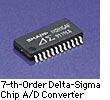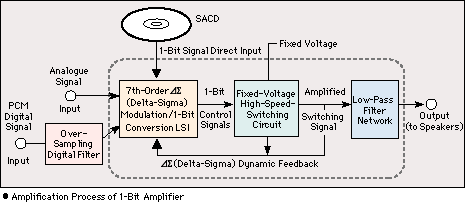|
|
|
|
 |
|
|
|
1-Bit Amplifier Operation Concept
|
|
|
 Sharp's SM-SX100 is based on the widely known class-D amplifier operating system. While class-D amplifiers use PCM to control the ON state by switching the high voltage, the SM-SX100 replaces the analogue-like PCM signals with 1-bit signals which have precise quartz-crystal accuracy to control switching the fixed-voltage power. Sharp's SM-SX100 is based on the widely known class-D amplifier operating system. While class-D amplifiers use PCM to control the ON state by switching the high voltage, the SM-SX100 replaces the analogue-like PCM signals with 1-bit signals which have precise quartz-crystal accuracy to control switching the fixed-voltage power.The "Delta-Sigma Dynamic Feedback" circuit feedbacks fluctuations of the voltage power to the 7th-order delta-sigma modulation LSI and corrects the 1-bit control signal in real time to create extremely stable amplification of music signal faithful to the original analogue signal. And a 1-bit signal stream faithful to the input data is created by high-speed (64 fs, 2.8224 MHz) sampling modulation. |
|
|
 |
|
|
| The newly developed 1-chip 7th-order delta-sigma modulation LSI plays a key part in this process to shift quantization noise to higher frequency and maintain a wide dynamic range in the audible band. At the final stage, the amplified switching signal is converted into an analogue signal used to drive the speakers by a low-pass filter network. From the input through to the speaker output there is no element of analogue amplification. The result is amplification with instantaneous transient response, an essential dynamic characteristic for musical reproduction, made possible by the high level of time resolution achieved by the high-speed sampling 1-bit control signal processing and the high-speed switching synchronized to the sampling frequency. From the dynamic expression of a fortissimo from silence at a stroke, to the static expression of the deepening silence of a pianissimo fade-out, Sharp's 1-bit amplifier has the rare ability to reproduce all music expressions. |
|
|
| The Merit of 1-Bit Amplifiers |
|
|
| Pure music transmission, superior power efficiency and enhanced space efficiency -- these are the advantages Sharp's 1-bit amplifier has over conventional amplifiers. By inputting 1-bit signals recorded on SACDs, the next generation format, directly to the 7th-order delta-sigma modulation LSI through the amplifier's exclusive 1-bit SACD input terminal, it is possible to digitally convey music signals without loss from the location where the music content was created to the point just in front of the speakers. SM-SX100 achieves pure sound transmission as sound that passes through the microphone is transmitted digitally to the speakers. Conventional analogue amplifiers rely on the linearity between input and output. Class-A and class-AB systems with good linearity are adopted in analogue amplifiers but they are highly inefficient and consume a lot of energy for high power output, hardly ideal from an environmental viewpoint. 1-bit digital amplifiers, on the other hand, when compared to conventional amplifiers, reduce heat radiation by four-fifths and use approximately half the power consumption due to their simple ON/OFF switching operation. This simple switching operation as well as other digital technologies not only allow for high energy-efficiency but make the 1-bit amplifier compact as well. |
|
|
|
|
|
|